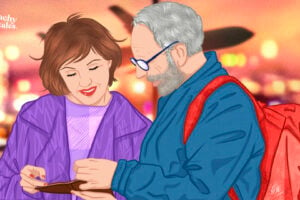The top 5 Romantic Paris Passageways
Have you ever seen Paris in the rain? Still beautiful but not the best set for a romantic stroll. For curious wanderers, there are better options: warm and well-lit covered passageways, galleries, shopping arcades in all their Belle Epoque glory.
There were about 150 arcades in the late 18th century in Paris, great places for the late bourgeois society to see and be seen. Nowadays only 15 or so passages are still alive. Mostly tucked into the Right Bank, they still have their own special character: beautiful mosaic floors, wrought iron shops signs, cosy bistrots, ornamental plaster bas-reliefs, trompe l’oeil and marble columns.
Galerie Vivienne, which runs off Rue des Petits-Champs, is probably the most famous passage. Designed in 1823 by the architect François-Jacques Delannoy, it is well known for its neo-classical touches with the canopy, paintings, sculptures of goddesses and nymphs and elegant arches. The mosaic floors were made by Italian artisans and their geometric shapes are reminiscent of the mosaics found on Rue de Rivoli. Don’t miss the elegant tea room À Priori Thé and the Librairie Jousseaume, an antiquarian bookshop.
Galerie Colbert is just on the next street over (Rue Vivienne). Home to the Institut National d’Histoire de l’Art and the Institut National du Patrimoine (which holds exhibitions and seminars there), it is well known for the striking rotunda, imposing statues and the nearby classic brasserie Le Grand Colbert.With its art nouveau mirrors, bulbous lamps and palm trees, it is the perfect setting for a romantic dejuner.
Passage des Panoramas, on Rue de Saint Marc, is just a stroll away. It is considered the first covered walkway in Paris. Built in 1799, it was occupied by stamp collectors and engravers and it still retains its old-fashioned charm and merchant spirit. Its style was inspired by oriental prints and had two amazing glass rotundas (both destroyed in 1831), the views from which offered impressive panoramas of the city from which the passage takes its name. This passageway is probably also the most cosmopolitan, yet touristic, arcade of Paris. Here, a variety of shops and cafés share the space with craftsmen, old stamps collectors and -of course- great architecture, such as those of the Chocolatier Marquis and Stern printing House, symbolising the ambitious planning from the 18th century and the Théâtre des Variétés (still active programming concerts and comedies).
Feeling peckish but still up and running? Then grab a baguette or a macaron and keep walking across Boulevard Montmartre, into the 9th arrondissement. There, on the back of the Passage des Panoramas, the glass-roofed Passage Jouffroy is waiting for you. Built in 1836, it has been one of the most visited covered arcades in the capital. It owes its charm to its beautiful iron and glass architecture, marble paving and lamps lining the arcade storefronts and curiosities boutiques. Passage Jouffroy is also home to the Musèe Grévin, the popular wax museum. Gourmets can take a break at Le Valentin, the unmissable tea room.
Passage Jouffroy leads to Passage Verdeau (rue de la Grange-Batelière). Opened in 1847, it takes the name of its creator. Today, it’s one of the most charming arcades and is lined with cafes, bookstores, and a number of antique dealers and unique shops (old books, postcards, collectors’ cameras, etc.). Note, the high glass roof, which was designed to look like fish bones, ended up to be the sunniest place among the Paris hidden galleries.




